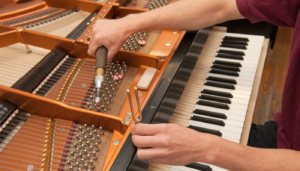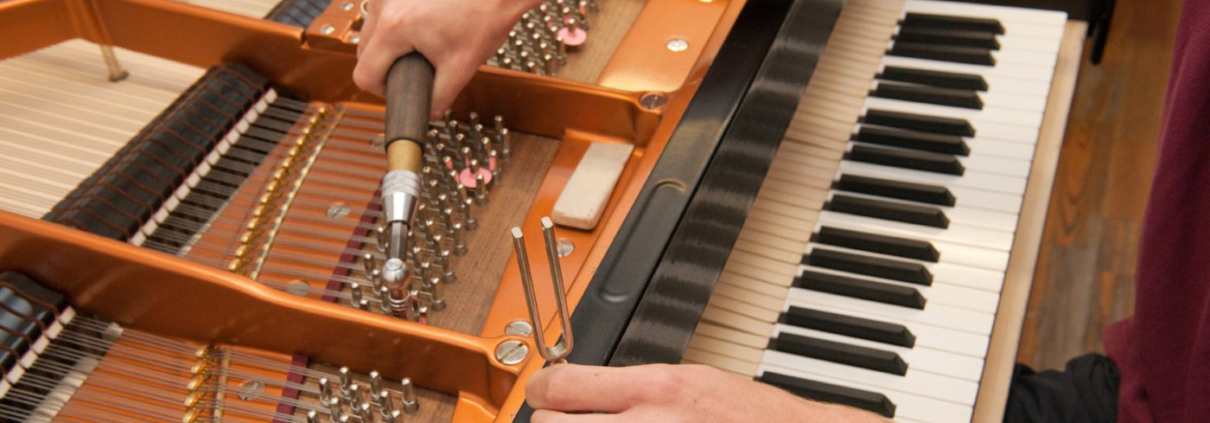Changing Piano Strings and What You Need to Know – Learn More About Piano Strings
Metal piano strings are composed of elastic steel with a high strength. They have a high tension tolerance; a piano string’s typical tension ranges from 70 to 90 kg. Generally speaking, the sound frequency and volume decrease with decreasing string size. The smallest string is the highest note on an acoustic piano. Conversely, the bass notes have extremely big strings, which frequently require an extra layer of copper wire to be wrapped around the string to enhance its diameter. This article will show you about changing piano strings and what you need to know. Let’s find out below!
See More :
- Top Piano Notes Sheet for Beginners
- Top 10 Best Pianos for Beginners
- How Can I Play Piano?
- Top 10 Best Piano Brands in 2024
- Best Piano of All Time
How many ways to change piano strings full set?
A typical piano has between 216 and 242 strings. The mid-frequency and high-frequency notes on the piano are composed of three strings that create a cluster rather than a single string like on guitars, violins, etc., which is why the piano only has 88 notes.
Each note on bass strings covered in copper can have two strings or only one (the very low sounds only have one string).
What are piano strings made of?
For Treble strings (3-string cluster) that are not coated in copper. When replacing, it’s important to measure the string’s actual diameter and select a replacement based on the dimensions listed in the size table below. The treble strings are arranged in pairs rather than individually; the middle section of each string is attached to the string holding pin below to create two parallel strings, and the two ends of the string are connected to two tuning pins. This implies that piano strings replacement consisting of two strings is also necessary when one breaks.

Each bass piano string set is a separate strand; yet, the piano’s diameter and length Bass strings are computed uniquely for every piano, not based on a standard table. When changing piano strings in bass type, you have two options: either send us sample strings or exact piano wire material, and we will rewind new strings to the appropriate piano wire sizes. Alternatively, you can search for pre-wound strings of an analogous size (universal bass string type).
Piano wire sizes
| Size | Φ (mm) | Length 500g |
| 12 | 0.725 | 154m |
| 12.5 | 0.750 | 145m |
| 13 | 0.775 | 135m |
| 13.5 | 0.800 | 126m |
| 14 | 0.825 | 119m |
| 14.5 | 0.850 | 112m |
| 15 | 0.875 | 105m |
| 15.5 | 0.900 | 100m |
| 16 | 0.925 | 94m |
| 16.5 | 0.950 | 89m |
| 17 | 0.975 | 85m |
| 17.5 | 1.000 | 81m |
| 18 | 1.025 | 77m |
| 18.5 | 1.050 | 73m |
| 19 | 1.075 | 70m |
| 19.5 | 1.100 | 67m |
| 20 | 1.125 | 64m |
| 20.5 | 1.150 | 61m |
| 21 | 1.175 | 58m |
| 21.5 | 1.200 | 56m |
| 22 | 1.225 | 54m |
| 23 | 1.300 | 48m |
| 24 | 1.400 | 41m |
| 25 | 1.500 | 36m |
| 26 | 1.600 | 31m |
Popular types of changing piano strings today
Piano strings come in two primary varieties: standard polygonal cross-section and circular cross-section. But round strings are seen in the majority of modern pianos.
Nowadays, a number of well-known companies manufacture piano wire material, including Mapes (produced in the US), Suzuki (made in Japan), and Roslau (made in Germany). Roslau strings are commonly seen in European-made pianos. Suzuki strings are used in Japanese pianos made by Yamaha, Kawai, and Toyo. Mapes strings are frequently found in pianos made in the US and Canada.
Furthermore, some companies manufacture Chinese piano strings. But it’s unclear how good these strings are.
Applications of Piano Wire Material
Piano wire is not just for the piano; it may also be used for other stringed instruments. Piano wire is specifically utilized for the following applications in addition to being used as a musical instrument because of its elasticity, toughness, and capacity to tolerate high tensile forces:
- Making industrial springs
- Making fishing hooks
- Applications in the construction industry
- Used in cutting machines.
- Used in the medical industry
Changing piano strings cost is kinda affordable; therefore, we recommend that if you are really not an expert, you should come to the Piano store! Hope you enjoy the article, we will tell you more about the piano in the very next articles.
Copy by : pianosintheparks.com




Leave a Reply
Want to join the discussion?Feel free to contribute!